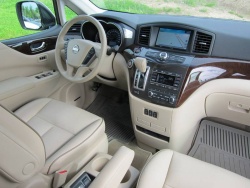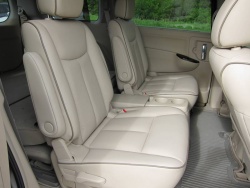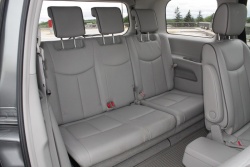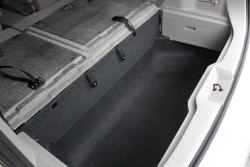    Top two photos: 2011 Nissan Quest LE; bottom photos, Quest SL, by Chris Chase. Click image to enlarge |
The offbeat exterior is wrapped around a far more conventional interior that’s one of the best-looking of the bunch. I wouldn’t want my tester’s beige carpets for daily family use, but my “Café Latte” leather seats sure look good (the other choice is grey). I could see taking this van, with its comfortable seats and thickly-padded armrests, on a road trip. The second-row seats are equally pleasant; the third row seats are flat, as they usually are, but they’re very easy to access, and substantial foot room under the second row gives passengers back there enough space for their legs. The Quest is strictly a seven-passenger van, since the second-row captain’s chairs can’t be swapped for a bench seat.
They can’t be removed, either. If you want to carry cargo, the second- and third-row seats fold forward, as they do on an SUV, to provide a flat floor. In most vans, the third row can be folded backwards into a well in the floor, and the second row can be taken out or, in Chrysler’s case, folded into the floor. This means the Quest has less overall cargo volume, although there’s still a lot of room, and it will probably only be a problem for those bringing home, say, a new refrigerator. What I really like about the configuration is that since the third row doesn’t flip backwards, what you’ll find behind it is a huge “trunk” hiding under the cargo floor. You can store items completely out of sight, and if you do need to fold the seats, everything can stay in there, since that space isn’t required for third-row stowage.
As is common with Nissan, the driver’s controls are simple and easy to use, even on my tester’s navigation system. What isn’t as simple is reaching them: the gearshift lever sticks out of the dash and is directly in the way. I found I was taking my eyes off the road too much to make sure I was reaching around and locating the correct button.
The entry S trim level contains air conditioning, first- and second-row power windows, cruise control, keyless entry with pushbutton start, removable second-row console, cloth seats, stereo with auxiliary jack, and 16-inch steel wheels. Moving up the trim ladder adds such things as 18-inch alloy wheels, tri-zone automatic climate control, rear-view monitor, Bluetooth, an iPod connector and leather seats. Exclusive to the LE are an advanced climate control system with odour eliminator, rear audio controls, navigation system, power-operated third-row seats (to raise them back up to a sitting position when they’re folded), second- and third-row sunshades, blind spot warning system, driver’s side memory, xenon headlamps, and a Bose stereo and rear-seat DVD system that can be optioned on the SL trim.
Common to all trim lines is a neat little feature tied in to the standard tire pressure monitoring system. When you put air in the tires, the horn will beep when you reach the correct pressure.
Where this newest Quest will end up in the minivan wars has yet to be determined, and it falls to such extremes that I’m hesitant to guess. Price-wise it’s up there with its Japanese competitors, but with a less-than-mainstream appearance. It’s more luxurious inside than its domestic and Korean contenders, but they don’t cost as much. I can’t see Nissan slicing off more than just a thin wedge of the segment with this fourth-generation Quest, but it won’t be for lack of trying.
|
Pricing: 2011 Nissan Quest LE
Specifications
Competitors
Crash test results
|











